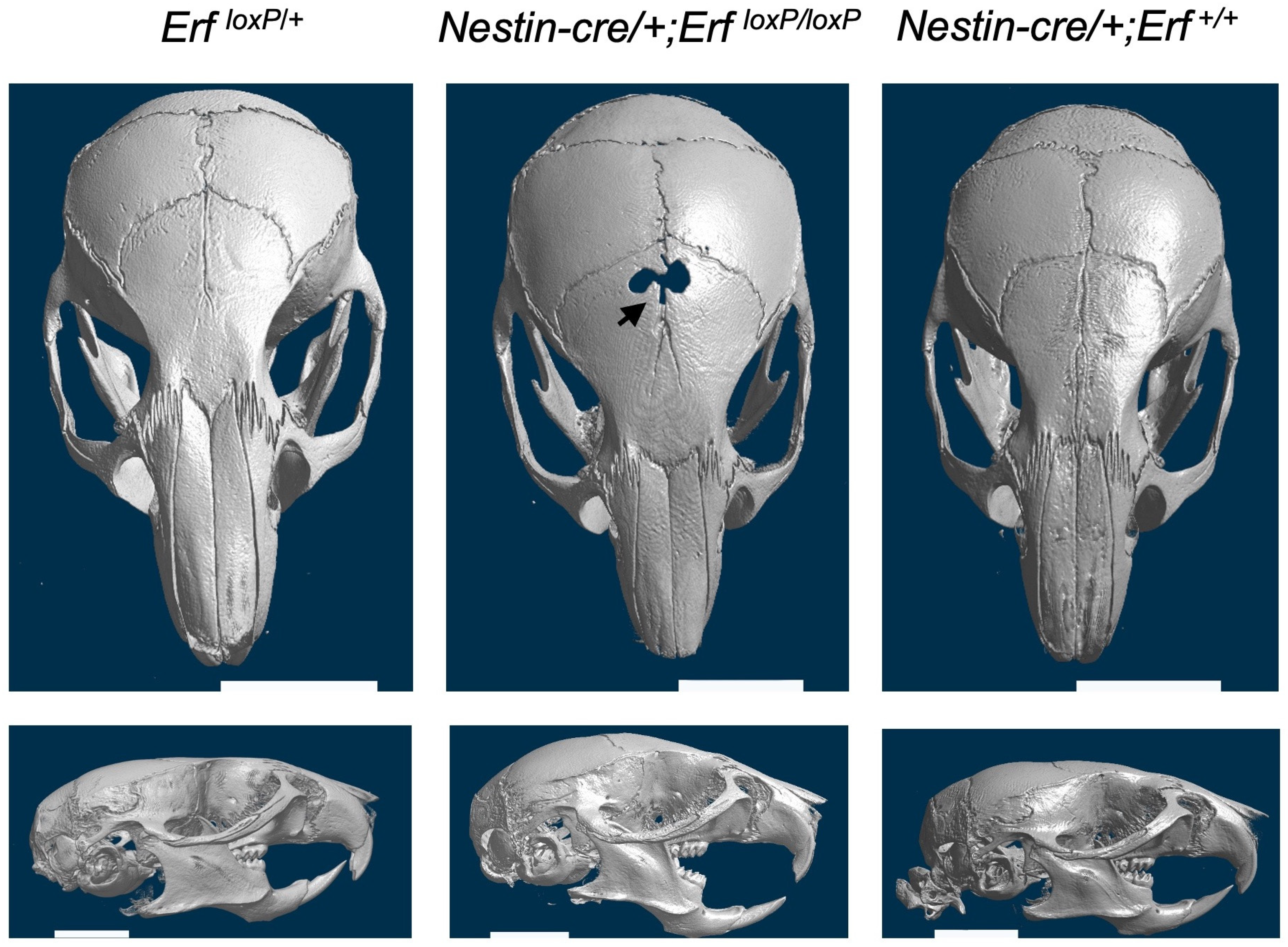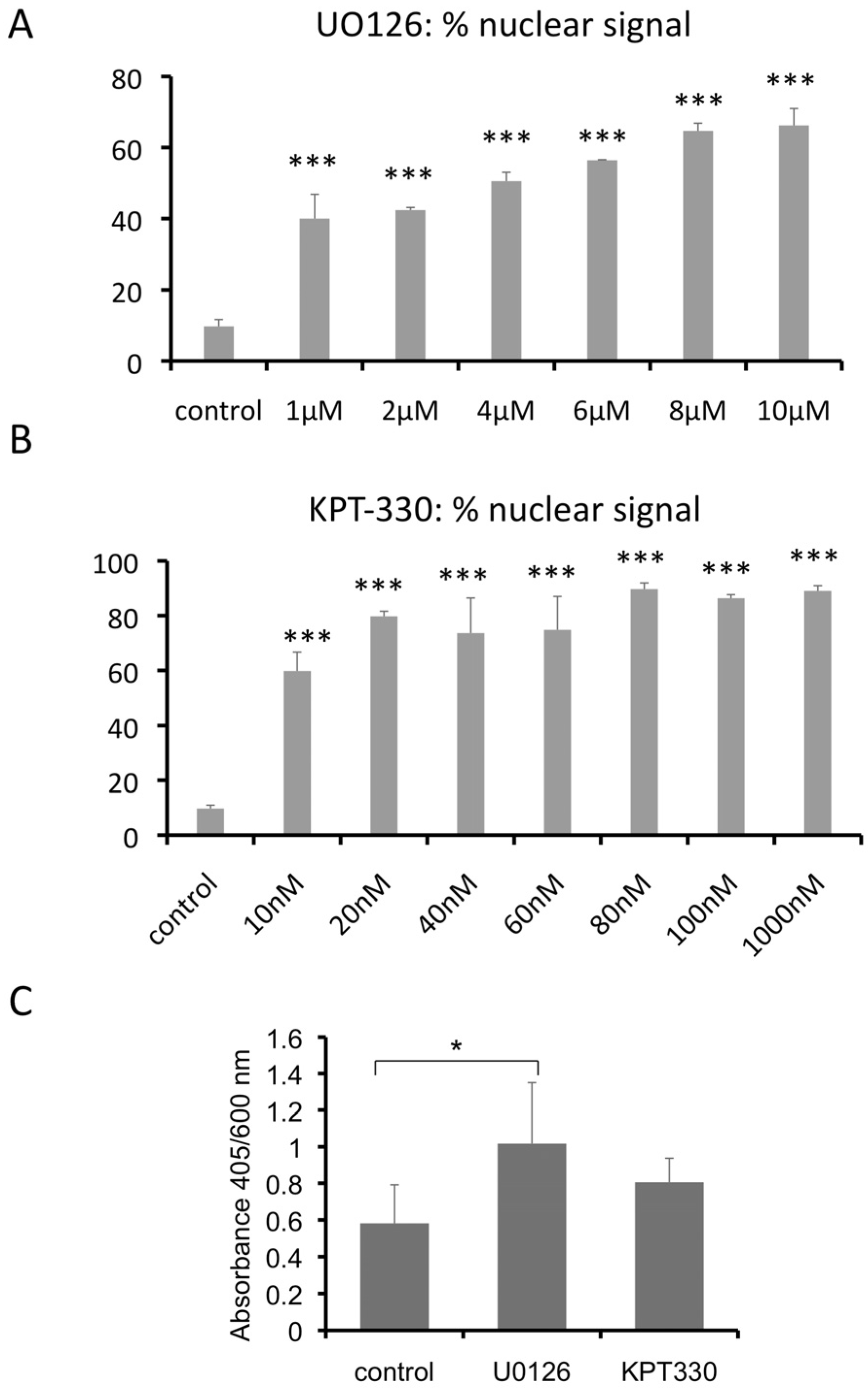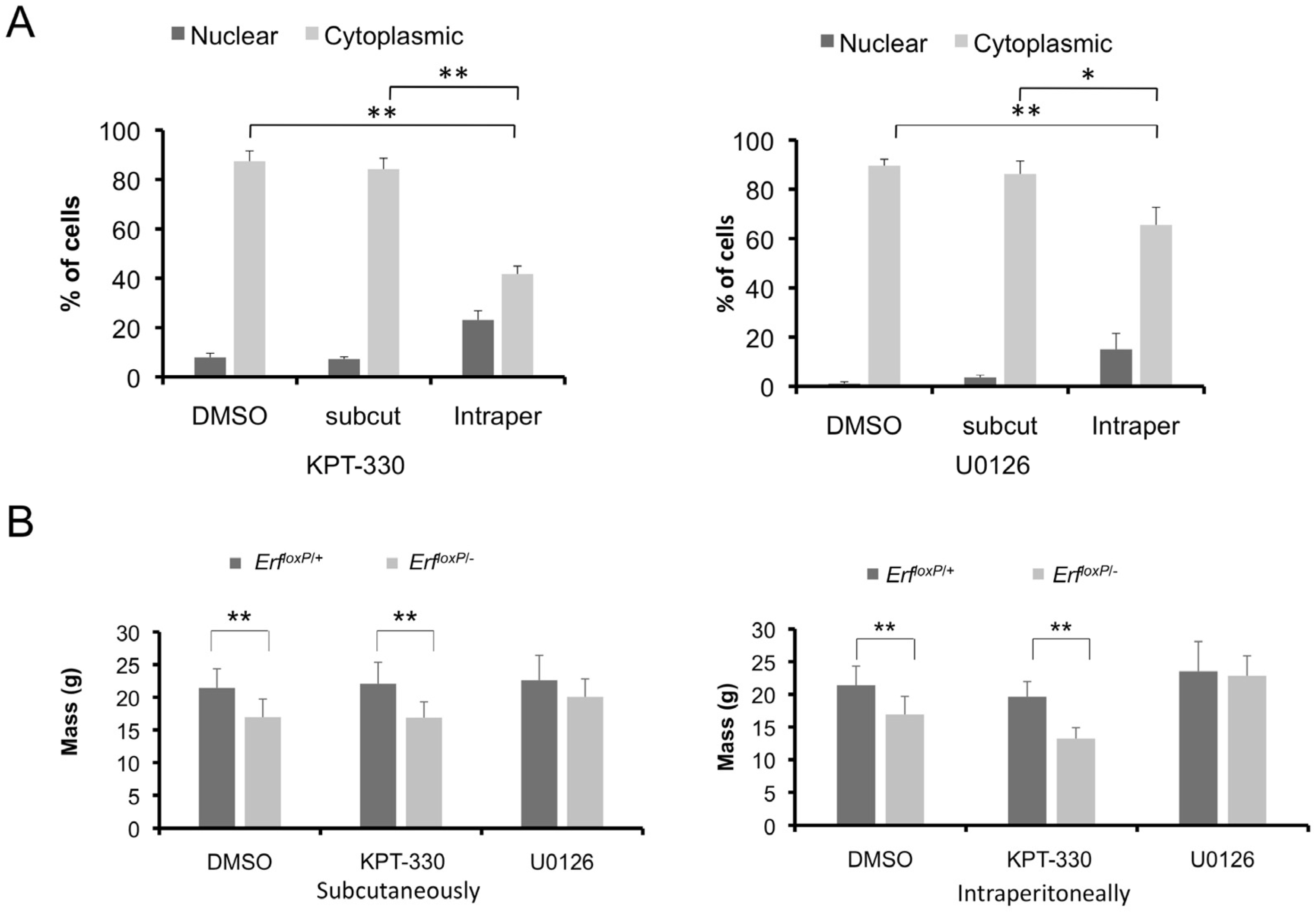Development of Erf-Mediated Craniosynostosis and Pharmacological Amelioration
Abstract
1. Introduction
2. Results
2.1. Erf Insufficiency in Mice Is Associated with Both Craniosynostosis and a Defect in the Development of Frontal Bones
2.2. Effect of Mek1/2 and Xpo1 Inhibitors on Erf Localization and on Differentiating Primary Suture-Derived Cells
2.3. Local Administration of U0126 and KPT-330 Compounds in Mice Does Not Have Serious System-Wide Effects
2.4. Mek1/2 and Xpo1 Inhibitor Administration Alleviates Suture Closure and Restores Skull Morphology in ErfloxP/− Mice
3. Discussion
4. Materials and Methods
4.1. Mouse Lines
4.2. Cell Lines and Transfection
4.3. Suture Cell Culture and Differentiation Assay
4.4. KPT-330 Preparation
4.5. Administration of Inhibitors in Animals and Skeletal Preparation
4.6. MicroCT Analysis
4.7. Calvaria Morphometric Analysis
4.8. Raman Spectroscopic Analysis
4.9. Single-Cell Correlation Analysis
4.10. Statistical Analysis
5. Conclusions
Supplementary Materials
Author Contributions
Funding
Institutional Review Board Statement
Informed Consent Statement
Data Availability Statement
Acknowledgments
Conflicts of Interest
References
- Morriss-Kay, G.M.; Wilkie, A.O. Growth of the normal skull vault and its alteration in craniosynostosis: Insights from human genetics and experimental studies. J. Anat. 2005, 207, 637–653. [Google Scholar] [CrossRef] [PubMed]
- Opperman, L.A. Cranial sutures as intramembranous bone growth sites. Dev. Dyn. 2000, 219, 472–485. [Google Scholar] [CrossRef] [PubMed]
- Mundinger, G.S.; Rehim, S.A.; Johnson, O., 3rd; Zhou, J.; Tong, A.; Wallner, C.; Dorafshar, A.H. Distraction Osteogenesis for Surgical Treatment of Craniosynostosis: A Systematic Review. Plast. Reconstr. Surg. 2016, 138, 657–669. [Google Scholar] [CrossRef] [PubMed]
- Morris, L. Management of Craniosynostosis. Facial. Plast. Surg. 2016, 32, 123–132. [Google Scholar] [CrossRef]
- Johnson, D.; Wilkie, A.O. Craniosynostosis. Eur. J. Hum. Genet. 2011, 19, 369–376. [Google Scholar] [CrossRef]
- Yin, L.; Du, X.; Li, C.; Xu, X.; Chen, Z.; Su, N.; Zhao, L.; Qi, H.; Li, F.; Xue, J.; et al. A Pro253Arg mutation in fibroblast growth factor receptor 2 (Fgfr2) causes skeleton malformation mimicking human Apert syndrome by affecting both chondrogenesis and osteogenesis. Bone 2008, 42, 631–643. [Google Scholar] [CrossRef]
- Shukla, V.; Coumoul, X.; Wang, R.H.; Kim, H.S.; Deng, C.X. RNA interference and inhibition of MEK-ERK signaling prevent abnormal skeletal phenotypes in a mouse model of craniosynostosis. Nat. Genet. 2007, 39, 1145–1150. [Google Scholar] [CrossRef]
- Pfaff, M.J.; Xue, K.; Li, L.; Horowitz, M.C.; Steinbacher, D.M.; Eswarakumar, J.V.P. FGFR2c-mediated ERK-MAPK activity regulates coronal suture development. Dev. Biol. 2016, 415, 242–250. [Google Scholar] [CrossRef]
- Vogiatzi, A.; Mavrothalassitis, G. Craniofacial, orofacial and dental disorders: The role of the RAS/ERK pathway. Expert. Rev. Mol. Med. 2019, 21, e2. [Google Scholar] [CrossRef]
- Glass, G.E.; O’Hara, J.; Canham, N.; Cilliers, D.; Dunaway, D.; Fenwick, A.L.; Jeelani, N.O.; Johnson, D.; Lester, T.; Lord, H.; et al. ERF-related craniosynostosis: The phenotypic and developmental profile of a new craniosynostosis syndrome. Am. J. Med. Genet. A 2019, 179, 615–627. [Google Scholar] [CrossRef]
- Twigg, S.R.; Vorgia, E.; McGowan, S.J.; Peraki, I.; Fenwick, A.L.; Sharma, V.P.; Allegra, M.; Zaragkoulias, A.; Sadighi Akha, E.; Knight, S.J.; et al. Reduced dosage of ERF causes complex craniosynostosis in humans and mice and links ERK1/2 signaling to regulation of osteogenesis. Nat. Genet. 2013, 45, 308–313. [Google Scholar] [CrossRef] [PubMed]
- Le Gallic, L.; Virgilio, L.; Cohen, P.; Biteau, B.; Mavrothalassitis, G. ERF nuclear shuttling, a continuous monitor of Erk activity that links it to cell cycle progression. Mol. Cell Biol. 2004, 24, 1206–1218. [Google Scholar] [CrossRef] [PubMed]
- Athanasiou, M.; LeGallic, L.; Watson, D.K.; Blair, D.G.; Mavrothalassitis, G. Suppression of the Ewing’s sarcoma phenotype by FLI1/ERF repressor hybrids. Cancer Gene 2000, 7, 1188–1195. [Google Scholar] [CrossRef] [PubMed]
- Le Gallic, L.; Sgouras, D.; Beal, G., Jr.; Mavrothalassitis, G. Transcriptional repressor ERF is a Ras/mitogen-activated protein kinase target that regulates cellular proliferation. Mol. Cell Biol. 1999, 19, 4121–4133. [Google Scholar] [CrossRef] [PubMed]
- Verykokakis, M.; Papadaki, C.; Vorgia, E.; Le Gallic, L.; Mavrothalassitis, G. The RAS-dependent ERF control of cell proliferation and differentiation is mediated by c-Myc repression. J. Biol. Chem. 2007, 282, 30285–30294. [Google Scholar] [CrossRef] [PubMed]
- Balasubramanian, M.; Lord, H.; Levesque, S.; Guturu, H.; Thuriot, F.; Sillon, G.; Wenger, A.M.; Sureka, D.L.; Lester, T.; Johnson, D.S.; et al. Chitayat syndrome: Hyperphalangism, characteristic facies, hallux valgus and bronchomalacia results from a recurrent c.266A>G p.(Tyr89Cys) variant in the ERF gene. J. Med. Genet. 2017, 54, 157–165. [Google Scholar] [CrossRef] [PubMed]
- Bose, R.; Karthaus, W.R.; Armenia, J.; Abida, W.; Iaquinta, P.J.; Zhang, Z.; Wongvipat, J.; Wasmuth, E.V.; Shah, N.; Sullivan, P.S.; et al. ERF mutations reveal a balance of ETS factors controlling prostate oncogenesis. Nature 2017, 546, 671–675. [Google Scholar] [CrossRef]
- Mayor-Ruiz, C.; Olbrich, T.; Drosten, M.; Lecona, E.; Vega-Sendino, M.; Ortega, S.; Dominguez, O.; Barbacid, M.; Ruiz, S.; Fernandez-Capetillo, O. ERF deletion rescues RAS deficiency in mouse embryonic stem cells. Genes. Dev. 2018, 32, 568–576. [Google Scholar] [CrossRef]
- Papadaki, C.; Alexiou, M.; Cecena, G.; Verykokakis, M.; Bilitou, A.; Cross, J.C.; Oshima, R.G.; Mavrothalassitis, G. Transcriptional repressor erf determines extraembryonic ectoderm differentiation. Mol. Cell Biol. 2007, 27, 5201–5213. [Google Scholar] [CrossRef]
- Peraki, I.; Palis, J.; Mavrothalassitis, G. The Ets2 Repressor Factor (Erf) Is Required for Effective Primitive and Definitive Hematopoiesis. Mol. Cell Biol. 2017, 37, e00183-17. [Google Scholar] [CrossRef]
- Vorgia, E.; Zaragkoulias, A.; Peraki, I.; Mavrothalassitis, G. Suppression of Fgf2 by ETS2 repressor factor (ERF) is required for chorionic trophoblast differentiation. Mol. Reprod. Dev. 2017, 84, 286–295. [Google Scholar] [CrossRef] [PubMed]
- Vogiatzi, A.; Baltsavia, I.; Dialynas, E.; Theodorou, V.; Zhou, Y.; Deligianni, E.; Iliopoulos, I.; Wilkie, A.O.M.; Twigg, S.R.F.; Mavrothalassitis, G. Erf Affects Commitment and Differentiation of Osteoprogenitor Cells in Cranial Sutures via the Retinoic Acid Pathway. Mol. Cell Biol. 2021, 41, e0014921. [Google Scholar] [CrossRef]
- Twigg, S.R.; Wilkie, A.O. A Genetic-Pathophysiological Framework for Craniosynostosis. Am. J. Hum. Genet. 2015, 97, 359–377. [Google Scholar] [CrossRef] [PubMed]
- Farmer, D.J.T.; Mlcochova, H.; Zhou, Y.; Koelling, N.; Wang, G.; Ashley, N.; Bugacov, H.; Chen, H.-J.; Parvez, R.; Tseng, K.-C.; et al. The developing mouse coronal suture at single-cell resolution. Nat. Commun. 2021, 12, 4797. [Google Scholar] [CrossRef]
- Holmes, G.; Gonzalez-Reiche, A.S.; Lu, N.; Zhou, X.; Rivera, J.; Kriti, D.; Sebra, R.; Williams, A.A.; Donovan, M.J.; Potter, S.S.; et al. Integrated Transcriptome and Network Analysis Reveals Spatiotemporal Dynamics of Calvarial Suturogenesis. Cell Rep. 2020, 32, 107871. [Google Scholar] [CrossRef] [PubMed]
- White, H.E.; Goswami, A.; Tucker, A.S. The Intertwined Evolution and Development of Sutures and Cranial Morphology. Front. Cell Dev. Biol. 2021, 9, 653579. [Google Scholar] [CrossRef] [PubMed]
- Sgouras, D.N.; Athanasiou, M.A.; Beal, G.J., Jr.; Fisher, R.J.; Blair, D.G.; Mavrothalassitis, G.J. ERF: An ETS domain protein with strong transcriptional repressor activity, can suppress ets-associated tumorigenesis and is regulated by phosphorylation during cell cycle and mitogenic stimulation. EMBO J. 1995, 14, 4781–4793. [Google Scholar] [CrossRef]
- Walker, J.S.; Garzon, R.; Lapalombella, R. Selinexor for advanced hematologic malignancies. Leuk. Lymphoma. 2020, 61, 2335–2350. [Google Scholar] [CrossRef]
- Wang, A.Y.; Liu, H. The past, present, and future of CRM1/XPO1 inhibitors. Stem. Cell Investig. 2019, 6, 6. [Google Scholar] [CrossRef]
- Parikh, K.; Cang, S.; Sekhri, A.; Liu, D. Selective inhibitors of nuclear export (SINE)—A novel class of anti-cancer agents. J. Hematol. Oncol. 2014, 7, 78. [Google Scholar] [CrossRef]
- Korberg, I.; Nowinski, D.; Bondeson, M.L.; Melin, M.; Kolby, L.; Stattin, E.L. A progressive and complex clinical course in two family members with ERF-related craniosynostosis: A case report. BMC Med. Genet. 2020, 21, 90. [Google Scholar] [CrossRef] [PubMed]
- Afshari, F.T.; Gallo, P.; Shafi, A.; Grant, J.; Drew, A.; Noons, P.; Jagadeesan, J.; Evans, M.; Brittain, H.; Rodrigues, D. ERF-related craniosynostosis and surgical management in the paediatric cohort. Childs Nerv. Syst. 2022; Online ahead of print. [Google Scholar]
- Durussel, J.; Liu, J.; Campbell, C.; Nam, H.K.; Hatch, N.E. Bone mineralization-dependent craniosynostosis and craniofacial shape abnormalities in the mouse model of infantile hypophosphatasia. Dev. Dyn. 2016, 245, 175–182. [Google Scholar] [CrossRef] [PubMed]
- Liu, J.; Campbell, C.; Nam, H.K.; Caron, A.; Yadav, M.C.; Millan, J.L.; Hatch, N.E. Enzyme replacement for craniofacial skeletal defects and craniosynostosis in murine hypophosphatasia. Bone 2015, 78, 203–211. [Google Scholar] [CrossRef]
- Liu, J.; Nam, H.K.; Wang, E.; Hatch, N.E. Further analysis of the Crouzon mouse: Effects of the FGFR2(C342Y) mutation are cranial bone-dependent. Calcif. Tissue Int. 2013, 92, 451–466. [Google Scholar] [CrossRef] [PubMed]
- Tarcic, G.; Avraham, R.; Pines, G.; Amit, I.; Shay, T.; Lu, Y.; Zwang, Y.; Katz, M.; Ben-Chetrit, N.; Jacob-Hirsch, J.; et al. EGR1 and the ERK-ERF axis drive mammary cell migration in response to EGF. FASEB J. 2012, 26, 1582–1592. [Google Scholar] [CrossRef] [PubMed]
- Yoshida, T.; Vivatbutsiri, P.; Morriss-Kay, G.; Saga, Y.; Iseki, S. Cell lineage in mammalian craniofacial mesenchyme. Mech. Dev. 2008, 125, 797–808. [Google Scholar] [CrossRef]
- Caunt, C.J.; Sale, M.J.; Smith, P.D.; Cook, S.J. MEK1 and MEK2 inhibitors and cancer therapy: The long and winding road. Nat. Rev. Cancer 2015, 15, 577–592. [Google Scholar] [CrossRef]
- Cheng, Y.; Tian, H. Current Development Status of MEK Inhibitors. Molecules 2017, 22, 1551. [Google Scholar] [CrossRef]
- Syed, Y.Y. Selinexor: First Global Approval. Drugs 2019, 79, 1485–1494. [Google Scholar] [CrossRef]
- Gabellini, D.; Tupler, R.; Green, M.R. Transcriptional derepression as a cause of genetic diseases. Curr. Opin. Genet. Dev. 2003, 13, 239–245. [Google Scholar] [CrossRef]
- Polychronopoulos, S.; Verykokakis, M.; Yazicioglu, M.N.; Sakarellos-Daitsiotis, M.; Cobb, M.H.; Mavrothalassitis, G. The transcriptional ETS2 repressor factor associates with active and inactive Erks through distinct FXF motifs. J. Biol. Chem. 2006, 281, 25601–25611. [Google Scholar] [CrossRef] [PubMed]
- Pricola, K.L.; Kuhn, N.Z.; Haleem-Smith, H.; Song, Y.; Tuan, R.S. Interleukin-6 maintains bone marrow-derived mesenchymal stem cell stemness by an ERK1/2-dependent mechanism. J. Cell Biochem. 2009, 108, 577–588. [Google Scholar] [CrossRef] [PubMed]
- Simann, M.; Le Blanc, S.; Schneider, V.; Zehe, V.; Ludemann, M.; Schutze, N.; Jakob, F.; Schilling, T. Canonical FGFs Prevent Osteogenic Lineage Commitment and Differentiation of Human Bone Marrow Stromal Cells Via ERK1/2 Signaling. J. Cell Biochem. 2017, 118, 263–275. [Google Scholar] [CrossRef] [PubMed]
- Matsushita, T.; Chan, Y.Y.; Kawanami, A.; Balmes, G.; Landreth, G.E.; Murakami, S. Extracellular signal-regulated kinase 1 (ERK1) and ERK2 play essential roles in osteoblast differentiation and in supporting osteoclastogenesis. Mol. Cell Biol. 2009, 29, 5843–5857. [Google Scholar] [CrossRef] [PubMed]
- Kyono, A.; Avishai, N.; Ouyang, Z.; Landreth, G.E.; Murakami, S. FGF and ERK signaling coordinately regulate mineralization-related genes and play essential roles in osteocyte differentiation. J. Bone. Min. Metab. 2012, 30, 19–30. [Google Scholar] [CrossRef] [PubMed]
- Tsang, E.J.; Wu, B.; Zuk, P. MAPK signaling has stage-dependent osteogenic effects on human adipose-derived stem cells in vitro. Connect. Tissue. Res. 2018, 59, 129–146. [Google Scholar] [CrossRef] [PubMed]
- Tan, H.; Zhao, C.; Zhu, Q.; Katakura, Y.; Tanaka, H.; Ohnuki, K.; Shimizu, K. Ursolic Acid Isolated from the Leaves of Loquat (Eriobotrya japonica) Inhibited Osteoclast Differentiation through Targeting Exportin 5. J. Agric. Food Chem. 2019, 67, 3333–3340. [Google Scholar] [CrossRef]
- Kajdic, N.; Spazzapan, P.; Velnar, T. Craniosynostosis—Recognition, clinical characteristics, and treatment. Bosn. J. Basic Med. Sci. 2018, 18, 110–116. [Google Scholar] [CrossRef]
- Tronche, F.; Kellendonk, C.; Kretz, O.; Gass, P.; Anlag, K.; Orban, P.C.; Bock, R.; Klein, R.; Schutz, G. Disruption of the glucocorticoid receptor gene in the nervous system results in reduced anxiety. Nat. Genet. 1999, 23, 99–103. [Google Scholar] [CrossRef]
- Xu, Y.; Malladi, P.; Chiou, M.; Longaker, M.T. Isolation and characterization of posterofrontal/sagittal suture mesenchymal cells in vitro. Plast. Reconstr. Surg. 2007, 119, 819–829. [Google Scholar] [CrossRef]
- James, A.W.; Levi, B.; Xu, Y.; Carre, A.L.; Longaker, M.T. Retinoic acid enhances osteogenesis in cranial suture-derived mesenchymal cells: Potential mechanisms of retinoid-induced craniosynostosis. Plast. Reconstr. Surg. 2010, 125, 1352–1361. [Google Scholar] [CrossRef] [PubMed]
- Gregory, C.A.; Gunn, W.G.; Peister, A.; Prockop, D.J. An Alizarin red-based assay of mineralization by adherent cells in culture: Comparison with cetylpyridinium chloride extraction. Anal. Biochem. 2004, 329, 77–84. [Google Scholar] [CrossRef] [PubMed]
- Sandanayaka, V.; Shacham, S.; McCauley, D.; Shechter, S. Hydrazide Containing Nuclear Transport Modulators and Uses Thereof. 7 February 2013. Available online: https://patents.google.com/patent/US9079865B2/en (accessed on 8 March 2023).
- Mandair, G.S.; Morris, M.D. Contributions of Raman spectroscopy to the understanding of bone strength. BoneKEy Rep. 2015, 4, 620. [Google Scholar] [CrossRef]
- Okagbare, P.I.; Esmonde-White, F.W.; Goldstein, S.A.; Morris, M.D. Development of non-invasive Raman spectroscopy for in vivo evaluation of bone graft osseointegration in a rat model. Analyst 2010, 135, 3142–3146. [Google Scholar] [CrossRef]
- Crane, N.J.; Morris, M.D.; Ignelzi, M.A.; Yu, G. Raman imaging demonstrates FGF2-induced craniosynostosis in mouse calvaria. J. Biomed. Opt. 2005, 10, 031119. [Google Scholar] [CrossRef] [PubMed]
- Zhou, Y.; Zhou, B.; Pache, L.; Chang, M.; Khodabakhshi, A.H.; Tanaseichuk, O.; Benner, C.; Chanda, S.K. Metascape provides a biologist-oriented resource for the analysis of systems-level datasets. Nat. Commun. 2019, 10, 1523. [Google Scholar] [CrossRef]






Disclaimer/Publisher’s Note: The statements, opinions and data contained in all publications are solely those of the individual author(s) and contributor(s) and not of MDPI and/or the editor(s). MDPI and/or the editor(s) disclaim responsibility for any injury to people or property resulting from any ideas, methods, instructions or products referred to in the content. |
© 2023 by the authors. Licensee MDPI, Basel, Switzerland. This article is an open access article distributed under the terms and conditions of the Creative Commons Attribution (CC BY) license (https://creativecommons.org/licenses/by/4.0/).
Share and Cite
Vogiatzi, A.; Keklikoglou, K.; Makris, K.; Argyrou, D.S.; Zacharopoulos, A.; Sotiropoulou, V.; Parthenios, N.; Gkikas, A.; Kokkori, M.; Richardson, M.S.W.; et al. Development of Erf-Mediated Craniosynostosis and Pharmacological Amelioration. Int. J. Mol. Sci. 2023, 24, 7961. https://doi.org/10.3390/ijms24097961
Vogiatzi A, Keklikoglou K, Makris K, Argyrou DS, Zacharopoulos A, Sotiropoulou V, Parthenios N, Gkikas A, Kokkori M, Richardson MSW, et al. Development of Erf-Mediated Craniosynostosis and Pharmacological Amelioration. International Journal of Molecular Sciences. 2023; 24(9):7961. https://doi.org/10.3390/ijms24097961
Chicago/Turabian StyleVogiatzi, Angeliki, Kleoniki Keklikoglou, Konstantinos Makris, Dionysia Stamatia Argyrou, Athanasios Zacharopoulos, Varvara Sotiropoulou, Nikolaos Parthenios, Angelos Gkikas, Maria Kokkori, Melodie S. W. Richardson, and et al. 2023. "Development of Erf-Mediated Craniosynostosis and Pharmacological Amelioration" International Journal of Molecular Sciences 24, no. 9: 7961. https://doi.org/10.3390/ijms24097961
APA StyleVogiatzi, A., Keklikoglou, K., Makris, K., Argyrou, D. S., Zacharopoulos, A., Sotiropoulou, V., Parthenios, N., Gkikas, A., Kokkori, M., Richardson, M. S. W., Fenwick, A. L., Archontidi, S., Arvanitidis, C., Robertson, J., Parthenios, J., Zacharakis, G., Twigg, S. R. F., Wilkie, A. O. M., & Mavrothalassitis, G. (2023). Development of Erf-Mediated Craniosynostosis and Pharmacological Amelioration. International Journal of Molecular Sciences, 24(9), 7961. https://doi.org/10.3390/ijms24097961






